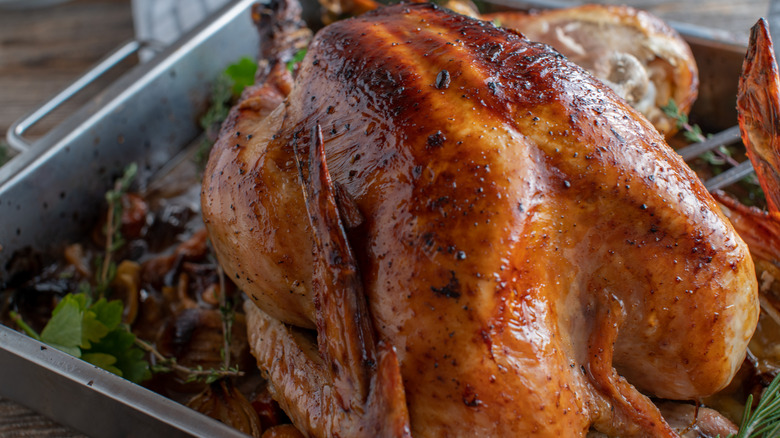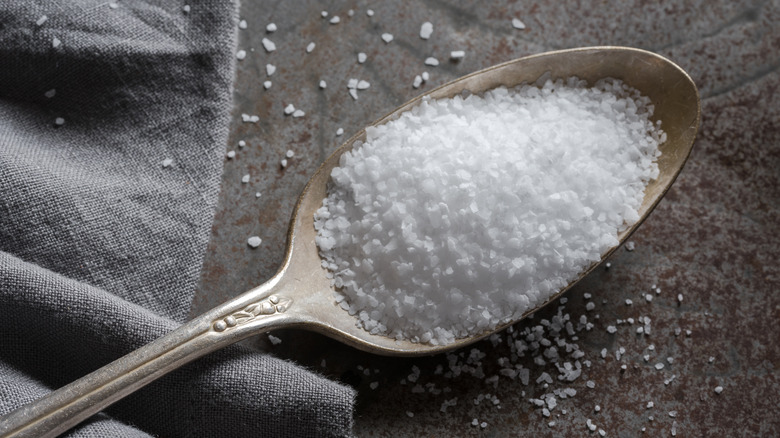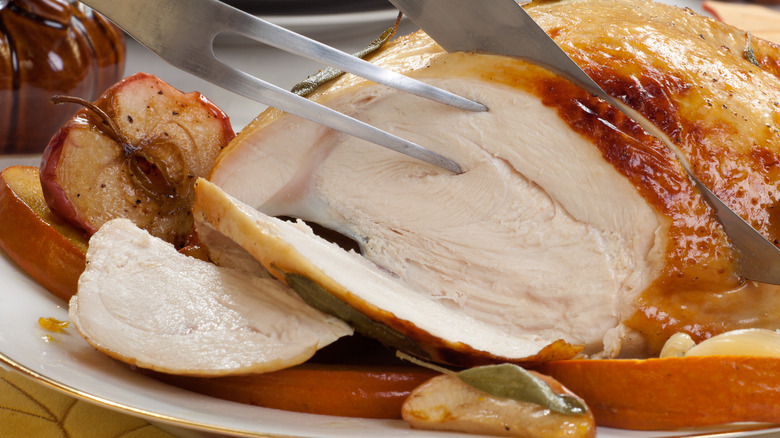The Golden Ratio For Salting Turkey Might Be More Than You Think
Salting turkey well before cooking has a few names, like "salt rubbing," "salt curing," or "dry brining." However, Alton Brown is begging you to stop saying "dry brine." He argues that the lack of a liquid means this can't be a brine. Technically, the author and host of "Good Eats" is correct. So, salt rubbing seems like the best answer, but Alton's too late. The "dry brine" cat is out of the bag. There's no getting it back in there.
A true brine for turkey is a tough task. You need a massive vessel to hold the brine and bird. Plus, it needs to be kept cool. That probably requires a second fridge. Even then, you still have a few gallons of raw turkey-infused liquid to deal with. Dry brining is more convenient and clean, and the results are worth the foresight of allowing for this time.
Dry brining takes a day for smaller birds, and up to two for large turkeys. During that time, the salt pulls moisture from the interior of the meat to the surface. That dissolves the salt, which can be reabsorbed into the meat. Thirty minutes of this is fine, but more time will allow for more seasoning to reach the interior of the meat. The result isn't salty; it's tender, well-seasoned, and satisfyingly savory.
The golden ratio for salting turkey is up for some debate
The preferred salt is kosher. It has a coarse texture that sticks to the meat better than table salt. Plus, most cooks agree that kosher salt is the only salt you ever need. The longer time also gives the salt a chance to tenderize the meat, in addition to seasoning.
There's some debate on the amount of kosher salt to use. The suggested amounts vary from ½ teaspoon of kosher salt per pound of turkey, all the way up to 1 teaspoon per pound of meat. For a first attempt, start with the lower amount. You can always add some finishing salt when the turkey is served. Also, the smaller amount is great for cooking a smaller cut of turkey, like a breast, or cutlet. For a whole turkey, the larger amount will be perfectly fine. All that being said, it should be noted — or even stressed — that the amount of salt for a dry brine can really vary.
When in doubt, Salt Your Meat is a dry-brining calculator for more than turkey. Just select the type of meat and the style of cut and enter the amount of meat. It'll calculate the amount of salt to use. It does the math for six types of salt, including the two most common kosher salts.
Your turkey is salted with the golden ratio. Now what?
Remember that there are two common types of kosher salt, and they measure quite differently. America's Test Kitchen explains that Diamond Crystal and Morton kosher salt are produced in different manners. That means they measure quite differently. The rule of thumb is 2 teaspoons of Diamond Crystal is equal to 1½ teaspoons of Morton kosher salt.
It's never a good idea to cook turkey directly from the fridge. For a whole turkey, let it rest at room temperature for up to an hour before cooking. Allowing the chill to come off of the bird before cooking, means that the temperature rise to the doneness you prefer will be gentle. The result is an evenly cooked turkey.
Finally, you should always let your meat rest after cooking. Turkey is no different. As meat cooks, the juices are squeezed out of the muscle fibers. That push continues after you take the turkey out of the oven. So, the general rule is to let a whole bird rest for 20 to 40 minutes. Cover loosely with foil during the rest to keep it from becoming too cold. Wrapping it tightly will just ruin the crispy skin.


